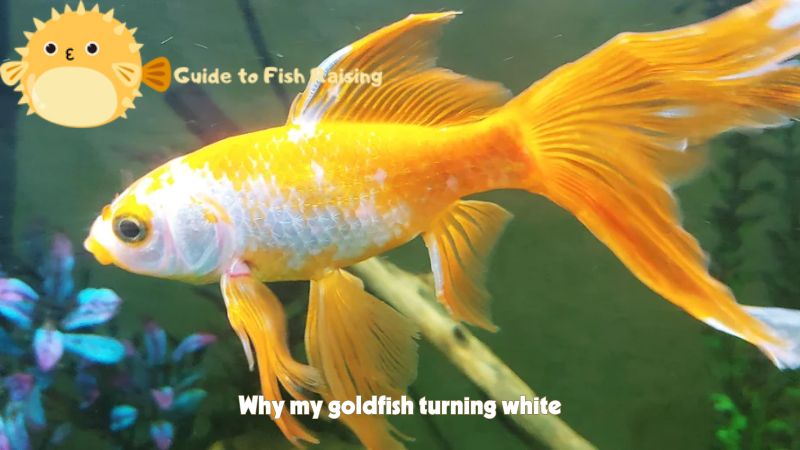Goldfish are unique fish species formed through thousands of years of selective breeding. This results in goldfish having many hidden genes, including color genes, which frequently affect the fish’s appearance.
Why my goldfish turning white? Simply put, if your goldfish gradually turns white with an evenly distributed symmetrical pattern, you have nothing to worry about. Goldfish genetics cause it and it’s completely normal. Let’s find out with fishtankenthusiast.com why my goldfish turning white?
Is it okay if my goldfish turns white?
Pay attention to the color distribution on the goldfish if the goldfish turns white in a symmetrical distribution; then that’s not a bad sign. However, irregular white patches, spots, and color changes indicate a potential health/environmental problem.
Goldfish became popular in China in the 9th century. They have a beautiful history associated with Buddhist traditions, which consider them a means of self-purification.
Goldfish were later domesticated and underwent selective breeding for their color in China about a thousand years ago. This resulted in a natural genetic mutation that created the beloved yellow color (sometimes referred to as orange-yellow).
The beauty of the goldfish breed became so popular that other colored goldfish, such as silver goldfish, became rare breeds. Recessive genes still lurk in your goldfish’s DNA, which is why it’s natural and common for your goldfish to change color as it matures. This natural variation is distributed in recognizable patterns, usually at the tips of the fins and tail.
On the other hand, irregular white color changes are normal in goldfish that are stressed, sick, or living in a bad environment. The first thing you want to do when you notice your goldfish changing color is to look at the water parameters; The culprit may lie there.
Why my goldfish turning white? And what to do?
Now that you know why goldfish change color, let’s find out why my goldfish turning white
Improper diet
A healthy diet for fish includes plenty of vitamin meals and foods naturally rich in pigment nutrients called carotenoids. Shrimp, krill, spinach, carrots and spirulina are some of the best examples of foods that help maintain the color of goldfish.
A poor diet will cause the fish to lack carotenoids, which is what causes goldfish to turn white, especially when combined with other factors such as weak UV light. Packaged fish food rich in canthaxanthin is great to address this cause. Canthaxanthin is an artificial pigment added to fish food that enhances the color of goldfish and can help reverse discoloration caused by improper diet.
Parasites, Infections and Diseases
This is the scariest reason. You’ve spent time becoming a skilled fish keeper, but now you have to face the downside of being a fish keeper, seeing your goldfish in pain.
Goldfish turning white is not associated with any specific disease. This is a symptom associated with many different diseases and the disease can only be identified through a combination of other symptoms. If your goldfish loses color but also loses appetite, is sluggish, and has lost weight, this could be a sign of infection. Fungal, bacterial and parasitic infections are the main causes.
Typical diseases that can cause goldfish to turn white include ich (white spot disease) and Malawi dropsy. Pay attention to how the white change looks. Deadly diseases tend to cause deadly white erosions due to conditions such as edema. Take your pet to an experienced professional for medical advice on how to proceed with treatment. It is good practice to always quarantine sick fish. Infections spread quickly in aquariums, and you don’t want your entire fish population to fall victim.

Poor water quality
Water quality is something you must put first when raising fish. This is what causes many problems for fish and ensuring you have the most optimal conditions at any given time will save you a lot of trouble.
Poor pH is the most common water quality problem that can cause goldfish to turn white. Discoloration also commonly occurs in water containing a lot of chlorine.
As you probably know, tap water in most homes comes from the main distribution system, which means it’s full of chlorine. Equip yourself with a test kit to ensure chlorine, pH, ammonia, nitrite and nitrate levels are at recommended levels. If the water quality is up to standard, this is not the reason why your fish turned white.
Avoid overfeeding your fish to keep good water quality. Goldfish are known for their friendly and easygoing nature, making you want to pamper them. You’d be forgiven for wanting to feed them every time they ask for food, but this will pollute the water and stress them in the long run.
Exposure
Ultraviolet light is the primary color of many animals. Goldfish pigments react to the intensity of ultraviolet light and change color accordingly.
Goldfish have two pigment cells: melanocytes for dark pigmentation and chromatophores for color. These cells come in a variety of colors depending on the species, but all produce a lighter color (white) when they do not receive enough UV light.
The reason why this is not the main cause of goldfish turning white is because the fish also receive some color-forming nutrients from their food. Meaning you can have a fish that doesn’t see much light but still retains its brilliant yellow color.
Goldfish thrive in environments with about 12 hours of sunlight or artificial light that provides ultraviolet rays. This is not only good for their color but also for their health, vibrancy and low stress levels.
Genetics
As seen earlier, goldfish are a man-made species and still have many recessive colors in their DNA. It’s difficult to know what color your goldfish will turn throughout its life unless you have access to the parents.
The quality of color present in the brood stock will be relatively stable but still not easy to predict. You may have one goldfish that turns from orange to white while another in the same tank turns from orange to black.
The dominant color in parent fish tends to be more stable. Therefore, you should talk to an expert about the color life cycle of fish to find out what color goldfish you might like. You should also be aware of any common recessive colors that may appear throughout your goldfish’s life cycle.
Your goldfish genetically turns white when you notice the color naturally moving toward the lower tips of the fins, especially the dorsal fin. Sadly, this is a natural process that we cannot control.
Old
Common color changes as goldfish mature include a transition from bronze to orange in the early years and orange to white in the later stages of the fish’s life. Adult goldfish can also turn from white to orange, black to orange, or orange to black.
Some goldfish species stop changing color after the first few years (usually two years), but others continue to change color for more than ten years.
Since goldfish can live up to 15 years in most cases, you may wonder how they have evolved during that time to change color. Well, the answer lies in the pigmentation.
Each fish species has a certain amount of pigment, which is almost fixed throughout the fish’s life. However, as the fish grows older, the pigment also increases, causing it to cover larger areas of the goldfish’s skin. As the pigments stretch further, the color of the fish begins to fade. Therefore, goldfish turn white as they age
Conclusion
The color of goldfish is one of the many attractive features that attract people to the hobby of fish keeping. It is important to keep fish color as a factor when raising any type of fish. This is a factor you have little control over, but the good news is you’ll rarely have to worry about it.
Start by understanding how a goldfish’s color depends on its pigmentation and how pigmentation is affected by environmental changes. Common factors that change pigment color include water quality and temperature.





